It's rare to do some prospective, but there has been recent development about probably the most important ground forces procurement program in Europe, it's main battle tank at the horizon of 2030-2040. This project is called the "Mobile Ground Combat System". Under this rather generic aconym lays the difficult replacement for the beloved de facto European Tank, the German Leopard 2, now a 46 years old platform, and the more recent, but more confidential French Leclerc. In the wake of French-German cooperation (which already failed in 1963), the launch of the 2017 program aimed at starting delivery in 2035. Impulsed by Politicians just like the SCAF it seems however with the war in Ukraine by 2022, emergency and constant industrial disagreements does not bodes well for the future of the program. The lead was to be shared in KNDS (2015 merger between German KMW and French Nexter) and Rheinmetall, KNDS presenting in 2019 a nice mix, the "Leoclerc", but things had changed since and by 2024 seems sour. What's the program status as of today ?

By the late 2010s it was obvious already that Germany felt that its beloved KMW/Rheinmetall Leopard 2 reached the limits of its development. So far, the 2A7, derived from the 1990s 2A6 and it's L/70 gun was introduced in 2017, just as the MGCS program was announced. The former was supposed to be a stopgap, an upgrade not only for the domestic Bundeswehr park of 2A5 (in second priority) and 2A6s (1st priority) but also a package (called the 2A7+) marketed to upgrade the Euro Park and beyond (Like Canada and Australia, Turkey...). Ir would ba relatively cheap solution to keep the Bundeswehr's main assets updated built more to "end" the production lines and use surplus, while freeing time and R&D to concentrate on its replacement, based this time on a brand new platform.
Even before the MGCS came in, Germany looked after a new platform because of a simple fact, that the Rheinmetall 120 mm main tank gun, although a fantastic piece of ordnance long derived from the British Chieftain's tank gun, was probably be outdated one day by new, heavier guns likely to be put up by Russia for a start. The latter indeed worked on improving 125 mm guns and NATO rumors prior to 2014 and the reveal of the T-14 Armata MBT led to believe that with a "crew cell" inside the chassis and a remotelly operated turret above it would be possible to place a larger gun, 130mm or even beyond. A larger caliber was to have an immense appeal both in terms of more raw impact power whatever the round used, larger APFSDS, larger HESH, Frag or HEAT round, but also in terms of range. Out-ranging the adversary meant keeping an edge in any set engagement. Everyone remembers Israeli Shot (Centurion)'s L7 105 mm guns mowing down advancing T-54/55s by droves on the Golan heights, in what became later the "valley of tears".

Thus, Rheinmetall started work as a private venture on a new, 140 mm main tank gun, knowing development time would take almost a decade, but it would jump directly to a potential Russian up-gunning and give the Leopard's sucessor's an edge until past 2050. A 140 mm caliber, would also mean larger, better ATGMs and even open the door to Anti-Air missiles as well. Some reports told about using these vehicles with clasic HE rounds with additional charge for artillery support at long range, used the same way as artillery and potentially perform this role as well far better than previous Leopards. So 6,000 meters in direct fire estimated, 20,000+ meters in parabolic fire with assisted rounds, and 12,000 meters in direct fire-and-forget mode tank gun ATGM of 3rd generation.
Later this caliber would be adopted by the MGCS, but in between, to test the waters, Rheinmetall unveiled its 130mm gun (a just up-scaled, rebored 120 mm) on the "KF51 Panther" as tech demonstrator. With this caliber, the shell weight meant an autloloader was mandatory, and the idea of a cell and remote turret went well with a 3-man crew despite the tank corps reservations about the increase in maintenance load. What is sure, is that an autoloader for a 140 mm gun would fir better in a Leopard 2A7 size turret compared to a classic "inhabited" one. All free space could be devoted to the loading system.
Thus from the start, France's timetable differed from the Bundeswehr. Before launching the Felin program, the army advocated a light, very mobile unit, tailored for interventions abroad and asymetric threats, Operation Serval and Barkhane being an excellent example of this new format. Just like many European countries, France looked at its immediate priorities and before 2022, high intensity war was not one of them. Thus, wheeled vehicles of the 1970s had replacement priorities. The first replacement to come out was the VBCI, followed more recently with the VBMR Griffon, Serval and EBRC Jaguar. All are wheeled vehicles taking the lessons of abroard interventions in 1995-2020.
The French also looked after upgrading the Leclerc with a larger gun and Nexter actually worked in 2021 on its own Ascalon 140 mm/52 tank gun demonstrator for the EMBT, tested with success as far as reported. The issue is its competition, as part of KNDS to the actual Rheinmetall's own programme. But this came as a major point of discord for the MGCS, dedpite a 2021 MOU signed defining the 2A6+ chassis, Leclerc autoloader, brand new turret and either RM or KNDS tank gun.
Despite the will of Politicians to see the creation of an "Airbus" of defence, obstacles are many, but a single battle tank for the whole of Europe would probably made much more sense, from an R&D perspective to sourcing and production network, including full assembly, in the whole Eurozone. This hypotherical new "europanzer", later called a time the "European Main Battle Tank" (EMBT) would thus have, if adopted by all, including Britain post-Brexit, a much lower cost than current systems, and a good complement to the Abrams brought by the US within NATO.
In spite of the difficulties, and within a relatively high point in somewhat always tense Franco-German relations, the program moved on. It first emerged by December 2014 as the Bundestag approved development for the next Gen. MBT under MoD Ursula von der Leyen. One of the accelerator back then was war in Donbass. At them time rports pilked up on the unpreparedness of the Bundeswehr and assessed the ageing park of frontline Leopard 2A6 were to be maintained until 2030. Analusts notably pointed out the use of tungsten ammunition making its penetrator rounds less effective against the latest Russian MBTs, such as later upgrades of the T-90 and the T-14 Armata.
Then, political discussions led to a rapprochement, at the initiative of the Germans to try to keep costs down. And negotiations between commenced between the German Krauss-Maffei Wegmann, and French Nexter under their respective government's pressure by the Summer of 2014, urging for a merged (KNDS) which could be able to share resources and R&D while finindg industrial know-how balance in order to fill the needs of the MGCS. The French parliament appeoved of this by January 2015, CEOs of both companies found many alleys of agreement on the new company's organigram, while expressing doubts about export restrictions. By July, the French National Assembly voted for the privatisation of Nexter, until then a state-owned defence company in order to join KMW. On 29 July the merger into KNDS was signed in Paris, completed in December 2015 with a new CEO, French born, german-speaking Stéphane Mayer, with chairman of the executive board Frank Haun for the holding.
With this crucial step taken, by 2016, the MGCS programme was officially launched as main project for KNDS, with schedule development completion optimistically set for by 2017. In 2016 asn Paris army show Eurosatory, Rheinmetall presented the "Advanced Technology Demonstrator" based on the Leopard 2A4 Evolution hull, later declined into the Panther KF51. Next in 2018, also at Eurosatory, KNDS showed to amused publics a quick "kitbash" like show tank under the E-MBT flag, hybrid made of the Leopard 2A7 hull and Leclerc turret. This model was never seriously proposed on the export market, as it would need much more time and effort to really combined both chassis and turret into a convincing, fully integrated combat platform. This was meredly a symbol of cooperation, but it went further.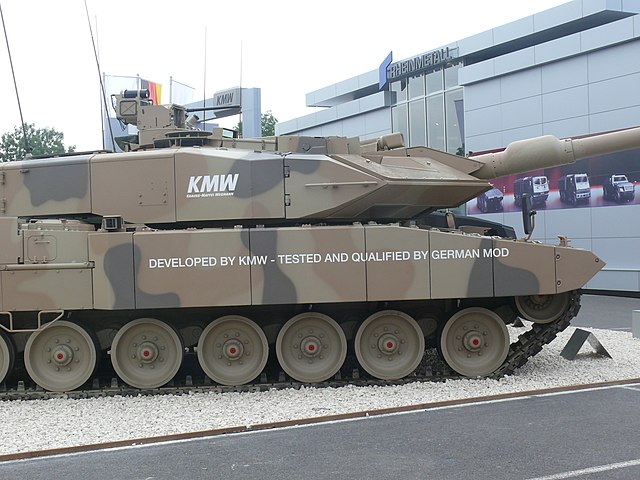
In June 2018 a new schedule for test trials was given for 2035 and full operational capability by 2040. On the other hand, the financing was unsure, and full-scale development was to wait to be launched that export customers came in. The R&D cost was indeed staggering as specifications piled up and complxity grew. It was not a Leopard III but a completely new platform, top to bottom. As for the Leopard 2, quite an export success for KMW was was the Leo 1, it was hoped that export customers would be found to at least ensure pre-financing, out of Germany and France alone. Both estimated c800 tanks in firm order (400 each) but this was for 2040 if the project was to succeed.
At last, optimism stepped in, by August 2019 French media reported both Italian and Polish MoDs declared interest in joining the project and to see it soon under EU's PESCO programme (European defence funding) to ease the bill further. Both indeed operated at the time their own brand of the Leopard 2. But more seriously, by September the Spanish Army expressed interest in turn. It was expected to replace its own domestically assembled fleet of Leopard 2E. However 2040 meant the latter, procured already almost two decades prior by 2025, would have to wait almost two more decades for replacement.
In November 2021 the Netherlands MoDs asked France and Germany to become observer. Still Franco-German negotiating conditions proved tough; notably to decide on which conditions other countries would be allowed to take part. However KNDS announced the Dutch an "important partner" in this discussion. France was initially reticent and preferred to wait until bilateral requirements were fixed, to not delay the program further by adding more partners adding their own domestic requirements. By January 2022, Belgium at last started to increase its defence spending and planned to enter MGCS, starting negociations.
As seen before, Poland was already negociating with Souh Korea, and the July 2022 Russian invasion of Ukraine precipitated things with a firm agreement for 1000 K2PL Black Panther and further cooperation with South Korea for the joint K3 tank, bailing out from MGCS for good. Worst was still to come: By September 2023 Germany, announced it found an agreement with Italy, Spain and Sweden for a successor to the Leopard 2 tank, thus nailing further the coffin of MGCS...
Indeed, Poland now firmly engaged with South Korea, Germany, italy, Spain, Sweden, all former users of the Leopard 2, joined development of the 2A7, not even presented as an "interim solution". France is left to continue development for its Leclerc replacement in an uncertain future. Thus in between as a "safety net" was developed a radical upgrade of the Leclerc mirroring German and british own short-term solutions (see later). To come back to the Senate report, MGCS represents for the senators a tricky balance between preservation of French know-how and are sceptical about the real reset of the program. Clearly it seemed to have stalled because of a divergence if vision between politicians and industrialists. Although the study phase was signed in 2024 to fix operational requirements, the shared industrial strategy balance is uncertain and makes all three partners at best nervous, at worst frustrated.
The senators consider how to "reboot" the project using the same "pillar method" used for the SCAF (8), and to lift doubts about real interest of German industrialists and their will (or rtather unwillingness) to share anything with Nexter and the German Government still advocating for Rheinmetall and KMW to finf common base, while admitting the completion of the process would be not before 2045 if no new strong implusion ios given. There is also a reluctance on the German side to favour the French added-value "fire function" trumpeted as more advanced than German solutions. The Senators also showed that Rheinmetall does not consider MGCS a priority a view supported by the German Government, shown by the new F-MBT program excluding nexter inside KNDS.
In their report, the Senators concludes urgent to finance and accelerate a radical upgrade program for the aging Leclerc MBT, with a first batch of 21 "renovés" (Upgraded) to be delivered in 2024 and not sufficient to cover the gap until 2040-45. They also saw value in KNDS to create a mobility platform and ease exports. However it is dubious as it would clash with the expected 2A7's own exports. Thus, it looks grim for France, equally stuck with the FCAS, Dassault repeating its commitment to develop alone a stealth, 6th gen replacement of the Rafale in shorter delays than the expected 2040+, while upgrading further the rafale to F5 standard, crossed with a further development of the nEUROn UAV and reach production as "loyal wingman" in 2030.
Development

By the late 2010s it was obvious already that Germany felt that its beloved KMW/Rheinmetall Leopard 2 reached the limits of its development. So far, the 2A7, derived from the 1990s 2A6 and it's L/70 gun was introduced in 2017, just as the MGCS program was announced. The former was supposed to be a stopgap, an upgrade not only for the domestic Bundeswehr park of 2A5 (in second priority) and 2A6s (1st priority) but also a package (called the 2A7+) marketed to upgrade the Euro Park and beyond (Like Canada and Australia, Turkey...). Ir would ba relatively cheap solution to keep the Bundeswehr's main assets updated built more to "end" the production lines and use surplus, while freeing time and R&D to concentrate on its replacement, based this time on a brand new platform.
Even before the MGCS came in, Germany looked after a new platform because of a simple fact, that the Rheinmetall 120 mm main tank gun, although a fantastic piece of ordnance long derived from the British Chieftain's tank gun, was probably be outdated one day by new, heavier guns likely to be put up by Russia for a start. The latter indeed worked on improving 125 mm guns and NATO rumors prior to 2014 and the reveal of the T-14 Armata MBT led to believe that with a "crew cell" inside the chassis and a remotelly operated turret above it would be possible to place a larger gun, 130mm or even beyond. A larger caliber was to have an immense appeal both in terms of more raw impact power whatever the round used, larger APFSDS, larger HESH, Frag or HEAT round, but also in terms of range. Out-ranging the adversary meant keeping an edge in any set engagement. Everyone remembers Israeli Shot (Centurion)'s L7 105 mm guns mowing down advancing T-54/55s by droves on the Golan heights, in what became later the "valley of tears".

Thus, Rheinmetall started work as a private venture on a new, 140 mm main tank gun, knowing development time would take almost a decade, but it would jump directly to a potential Russian up-gunning and give the Leopard's sucessor's an edge until past 2050. A 140 mm caliber, would also mean larger, better ATGMs and even open the door to Anti-Air missiles as well. Some reports told about using these vehicles with clasic HE rounds with additional charge for artillery support at long range, used the same way as artillery and potentially perform this role as well far better than previous Leopards. So 6,000 meters in direct fire estimated, 20,000+ meters in parabolic fire with assisted rounds, and 12,000 meters in direct fire-and-forget mode tank gun ATGM of 3rd generation.
Later this caliber would be adopted by the MGCS, but in between, to test the waters, Rheinmetall unveiled its 130mm gun (a just up-scaled, rebored 120 mm) on the "KF51 Panther" as tech demonstrator. With this caliber, the shell weight meant an autloloader was mandatory, and the idea of a cell and remote turret went well with a 3-man crew despite the tank corps reservations about the increase in maintenance load. What is sure, is that an autoloader for a 140 mm gun would fir better in a Leopard 2A7 size turret compared to a classic "inhabited" one. All free space could be devoted to the loading system.
France's replacement for the Leclerc
It should be mentioned at this point that France also had this replacement pressure, but not at the same level as Germany. In 1978, France tried to upgrade its 1960s AMX-30 and failed to find export customers that could have partly funded an hypothetic AMX-40/50. It had to wait until the late 1980s to find in the UAE a viable partner for the Main Battle Tank that became the Leclerc, entering service after the end of the cold war and more than a decade after the Leopard 2. Thus, given the life expectanly of such weapon system, France did not felt the need to change, only upgrade its Leclerc, now "made" by Nexter, and after 2015, by KNDS. In reality only upgrade packages were planned, production ceased on the early 2000s as the ordered park of 400 had been delivered, minus those of the UAE.Thus from the start, France's timetable differed from the Bundeswehr. Before launching the Felin program, the army advocated a light, very mobile unit, tailored for interventions abroad and asymetric threats, Operation Serval and Barkhane being an excellent example of this new format. Just like many European countries, France looked at its immediate priorities and before 2022, high intensity war was not one of them. Thus, wheeled vehicles of the 1970s had replacement priorities. The first replacement to come out was the VBCI, followed more recently with the VBMR Griffon, Serval and EBRC Jaguar. All are wheeled vehicles taking the lessons of abroard interventions in 1995-2020.
The French also looked after upgrading the Leclerc with a larger gun and Nexter actually worked in 2021 on its own Ascalon 140 mm/52 tank gun demonstrator for the EMBT, tested with success as far as reported. The issue is its competition, as part of KNDS to the actual Rheinmetall's own programme. But this came as a major point of discord for the MGCS, dedpite a 2021 MOU signed defining the 2A6+ chassis, Leclerc autoloader, brand new turret and either RM or KNDS tank gun.
Enters the MGCS programme
The fact is in 2017, both countries were steered towards closer cooperation to built a "European defence", an old sea serpent seen by many as an unacceptable rival of NATO, and it was stressed one white paper after another, that the diversity in European procurement was counter-productive, not cost-effective, unlike the US which managed to reach lower costs overall despite amssive R&D thanks to a larger home market, incidentally also pushing exports, notably towards Europe. The continent as a whole has a GDP, al the know-how, high-end industries and startup networks able to perform work on a next generation main battle tank. The issue is mostly relative to national industries which jealously guard their own technological capital.Despite the will of Politicians to see the creation of an "Airbus" of defence, obstacles are many, but a single battle tank for the whole of Europe would probably made much more sense, from an R&D perspective to sourcing and production network, including full assembly, in the whole Eurozone. This hypotherical new "europanzer", later called a time the "European Main Battle Tank" (EMBT) would thus have, if adopted by all, including Britain post-Brexit, a much lower cost than current systems, and a good complement to the Abrams brought by the US within NATO.
In spite of the difficulties, and within a relatively high point in somewhat always tense Franco-German relations, the program moved on. It first emerged by December 2014 as the Bundestag approved development for the next Gen. MBT under MoD Ursula von der Leyen. One of the accelerator back then was war in Donbass. At them time rports pilked up on the unpreparedness of the Bundeswehr and assessed the ageing park of frontline Leopard 2A6 were to be maintained until 2030. Analusts notably pointed out the use of tungsten ammunition making its penetrator rounds less effective against the latest Russian MBTs, such as later upgrades of the T-90 and the T-14 Armata.
Then, political discussions led to a rapprochement, at the initiative of the Germans to try to keep costs down. And negotiations between commenced between the German Krauss-Maffei Wegmann, and French Nexter under their respective government's pressure by the Summer of 2014, urging for a merged (KNDS) which could be able to share resources and R&D while finindg industrial know-how balance in order to fill the needs of the MGCS. The French parliament appeoved of this by January 2015, CEOs of both companies found many alleys of agreement on the new company's organigram, while expressing doubts about export restrictions. By July, the French National Assembly voted for the privatisation of Nexter, until then a state-owned defence company in order to join KMW. On 29 July the merger into KNDS was signed in Paris, completed in December 2015 with a new CEO, French born, german-speaking Stéphane Mayer, with chairman of the executive board Frank Haun for the holding.
With this crucial step taken, by 2016, the MGCS programme was officially launched as main project for KNDS, with schedule development completion optimistically set for by 2017. In 2016 asn Paris army show Eurosatory, Rheinmetall presented the "Advanced Technology Demonstrator" based on the Leopard 2A4 Evolution hull, later declined into the Panther KF51. Next in 2018, also at Eurosatory, KNDS showed to amused publics a quick "kitbash" like show tank under the E-MBT flag, hybrid made of the Leopard 2A7 hull and Leclerc turret. This model was never seriously proposed on the export market, as it would need much more time and effort to really combined both chassis and turret into a convincing, fully integrated combat platform. This was meredly a symbol of cooperation, but it went further.
EMBT scheduled and "pre-exported"

In June 2018 a new schedule for test trials was given for 2035 and full operational capability by 2040. On the other hand, the financing was unsure, and full-scale development was to wait to be launched that export customers came in. The R&D cost was indeed staggering as specifications piled up and complxity grew. It was not a Leopard III but a completely new platform, top to bottom. As for the Leopard 2, quite an export success for KMW was was the Leo 1, it was hoped that export customers would be found to at least ensure pre-financing, out of Germany and France alone. Both estimated c800 tanks in firm order (400 each) but this was for 2040 if the project was to succeed.
At last, optimism stepped in, by August 2019 French media reported both Italian and Polish MoDs declared interest in joining the project and to see it soon under EU's PESCO programme (European defence funding) to ease the bill further. Both indeed operated at the time their own brand of the Leopard 2. But more seriously, by September the Spanish Army expressed interest in turn. It was expected to replace its own domestically assembled fleet of Leopard 2E. However 2040 meant the latter, procured already almost two decades prior by 2025, would have to wait almost two more decades for replacement.
2020s developments
By February 2020 French Pdt Emmanuel Macron flew to Warsaw for discussions over the Polish procurement looked at its participation in MGCS, however already the full agreement between partners were delayed as negociations between Rheinmetall and KWM to join KNDS was stalling. At least in May, the contract System Architecture Definition Study contract was signed by the German armed forces procurement office, Rheinmetall entering KNDS to look for national interoperability, harmonising requirements, defining workshare over 18 months. it was annoubced that the Technology Demonstration Phase (TDP) would be completed by 2024 with the overall system demonstrator phase (GSDP) up to 2028, and hopefully pre-production, tests.Poland and Italy bailing out
But this pace annoyed previously joining partners.¨Poland, confronted by an ever present threat of open conflict with neighbouring Russia (it was even well pre-2022 invasion) decided to launch the Wilk program to procure rapidly c1000 tanks to replace both T-72/PT-91s now obsolete. Not wanting to wait until 2040 while not officially bailing out from the program, Poland entered negociations with the only provider that could deliver the goods under very tight scheduled at a very competitive prices: Hyundai Rotem started back then negociations, which will eventually lead to a firm order for the K2 Black Panther, to be manufactured under licence as the "Wilk" (Wolf). Italy meanwhile, had a change of government and by December 2020 announced its withdawal of the MGCS and own development, offering Poland and Spain to join in.Other partners and changes
By early 2021 the United Kingdom entered talks to join MGCS as observer, for a long term replacement of the ageing Challenger 2. In the meantime later, the MoD chosed the Challenger 3 turret replacement programme as an interim life extension program, due to enter service by 2027. It was also considered the purchase of German Leopard 2A7s as second interim option. By 15 October 2021, Sweden declared its interest to join MGCS as observer.In November 2021 the Netherlands MoDs asked France and Germany to become observer. Still Franco-German negotiating conditions proved tough; notably to decide on which conditions other countries would be allowed to take part. However KNDS announced the Dutch an "important partner" in this discussion. France was initially reticent and preferred to wait until bilateral requirements were fixed, to not delay the program further by adding more partners adding their own domestic requirements. By January 2022, Belgium at last started to increase its defence spending and planned to enter MGCS, starting negociations.
As seen before, Poland was already negociating with Souh Korea, and the July 2022 Russian invasion of Ukraine precipitated things with a firm agreement for 1000 K2PL Black Panther and further cooperation with South Korea for the joint K3 tank, bailing out from MGCS for good. Worst was still to come: By September 2023 Germany, announced it found an agreement with Italy, Spain and Sweden for a successor to the Leopard 2 tank, thus nailing further the coffin of MGCS...
MGCS postponed, interim solutions
By January 2024 a French Senate commission was elected to examine the status of both the MGCS and FCAS (future European stealth fighter, also with Germany and other partners), worry of recent developments indicating France was the only one apparently actively involved in MGCS. In the context of rapid rearmament due to the return of hig intensity combat, US indecisive posture for the future (Trump potential election, Ukraine aid still blocked) France through its president expressed the will to accelerate European commitment to an integrated defence, and drastically ramping up ammunition production. This new 2022 context is not a chance for MGCS but seemingly a curse as its long-term nature precludes any procurement at a useful time, if the war in Ukraine would evolve in unfavourable terms for Western Europe.Indeed, Poland now firmly engaged with South Korea, Germany, italy, Spain, Sweden, all former users of the Leopard 2, joined development of the 2A7, not even presented as an "interim solution". France is left to continue development for its Leclerc replacement in an uncertain future. Thus in between as a "safety net" was developed a radical upgrade of the Leclerc mirroring German and british own short-term solutions (see later). To come back to the Senate report, MGCS represents for the senators a tricky balance between preservation of French know-how and are sceptical about the real reset of the program. Clearly it seemed to have stalled because of a divergence if vision between politicians and industrialists. Although the study phase was signed in 2024 to fix operational requirements, the shared industrial strategy balance is uncertain and makes all three partners at best nervous, at worst frustrated.
The senators consider how to "reboot" the project using the same "pillar method" used for the SCAF (8), and to lift doubts about real interest of German industrialists and their will (or rtather unwillingness) to share anything with Nexter and the German Government still advocating for Rheinmetall and KMW to finf common base, while admitting the completion of the process would be not before 2045 if no new strong implusion ios given. There is also a reluctance on the German side to favour the French added-value "fire function" trumpeted as more advanced than German solutions. The Senators also showed that Rheinmetall does not consider MGCS a priority a view supported by the German Government, shown by the new F-MBT program excluding nexter inside KNDS.
In their report, the Senators concludes urgent to finance and accelerate a radical upgrade program for the aging Leclerc MBT, with a first batch of 21 "renovés" (Upgraded) to be delivered in 2024 and not sufficient to cover the gap until 2040-45. They also saw value in KNDS to create a mobility platform and ease exports. However it is dubious as it would clash with the expected 2A7's own exports. Thus, it looks grim for France, equally stuck with the FCAS, Dassault repeating its commitment to develop alone a stealth, 6th gen replacement of the Rafale in shorter delays than the expected 2040+, while upgrading further the rafale to F5 standard, crossed with a further development of the nEUROn UAV and reach production as "loyal wingman" in 2030.
"Chally 3", only a turret upgrade ?
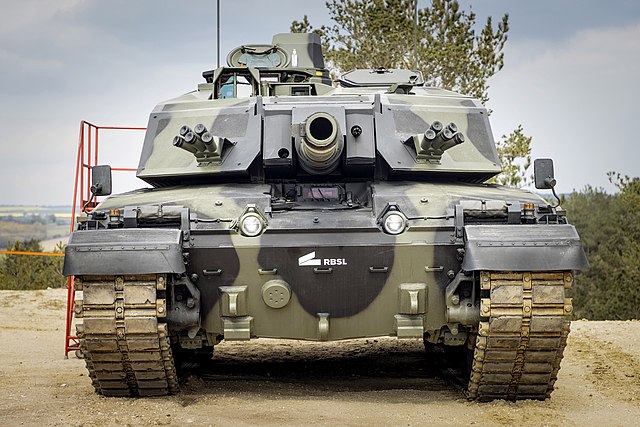
Challenger 3 (CR3) as planned today is a conversion of existing Challenger 2 by British/German Rheinmetall BAE Systems Land joint venture. The program was launched as far back as 2005 under the Capability And Sustainment Programme (CSP) to allow the MBT to stay relevant until the 2030s. But only on 2024 was voted the "Challenger 2 Life Extension Programme" (LEP). A prototype was to be procured by BAE Systems in 2018 and Rheinmetall in 2019 for comparative test, before the merger into Rheinmetall BAE Systems Land (RBSL). The program stresses the use of an all-new turret but the chassis being an improved hull as well. Main change is the 120 mm L55A1 smoothbore gun derived from the Leopard 2A6/A7 for better NATO commonality, Ammunition to be developed with Rheinmetall AG and a new range offered to the Challenger 3 and Leopard 2. In all, 148 are about to be upgraded 2027-2030.
Leopard 2A7/2A7+

The latest evolution of the Leopard 2, based on the 2A6, is now poised at replacing older fleets for all European users (c1500 tanks a the least), which made ROI worth the R&D expanses by KMW/Rheinmetall. Main features includes new armor notably around the turret rear, an energy system, crew compartment cooling system, new weapon engagement system. The previosu 2A7+ is not optimized for urban combat, and they started to be delivered by December 2014, 14 vehicles sent for field tests with Tank Battalion 203, 4 to the Armoured Corps Training Centre, one to the Technical School for Land Systems.
May 2017 saw the signing of the upgrade of 20 existing Leopard 2A7s into the 2A7V variant. Soon, Norway also started evaluating the 2A7 for aquisition as conformed by the Mod (2A7NO). A few years later by May 2022, the Czech MoD Jana Černochová negociated the purchase of 40 2A7 while later Norway signed for 54. On February 10, 2023 the Greek government signed the upgrade of 123 Leopard 2A4 as 2A7H. By March 8, 2023, as said above, Italy declared intyerest to sign for 250 Leopard 2A7, all new builts. Bulgaria also signed and obtained the new 2A7HU by December 14, 2023. The Hungarian MoD also signed signed by December 19, 2018 in its "Zrínyi 2026" Program for 44 new buult Leopard 2A7+.
Panther Kf.31

The Panther KF51 ("Kettenfahrzeug" 51, in development from 2016) is the latest German main battle tank under development by Rheinmetall Landsysteme (Rheinmetall's Vehicle Systems division). Publicly displayed at Eurosatory 2022 in June, it certainly was one of the biggest event in the show. Altough based on the Leopard 2A4 chassis, the latter was mated with brand new turret, featuring a brand new and innovatibe 130 mm main tank gun, fully automated and autoloaded. On 5 December 2022, Rheinmetall announced it was tailored for nation already operating earlier brands of the Leopard 2.
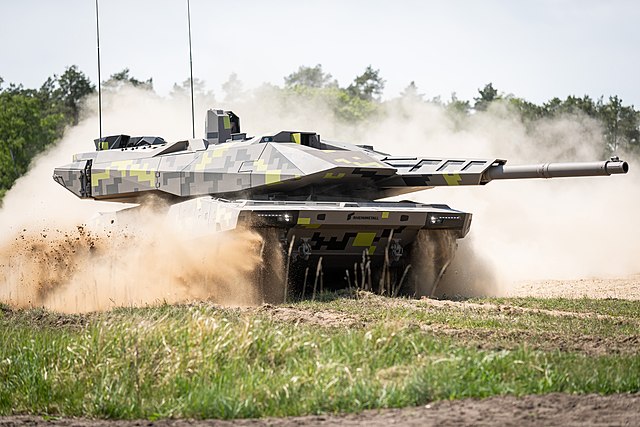
Rheinmetall started the vehicle as a private venture, completely outside the scope of KNDS project, but obviously it's a showcase intended both for the German Governbment deciders and potential export customers. It was scheduled to potential state official evaluation in 2026. Apart the 130 mm main gun, which is a novelty in caliber and operation, perhaps setting the stage for a new Euro standard, the way it copes with extra weight is through the choice of emphasise active over passive protection. Indee the idea any armour would be defeated by ammunitions in 1955 was prevalent during the Leopard I early design, and at the time, emphasised mobility over passive protection. Now with far better targeting systems, even the fastest tank is toasted when caught in a scope. Thus, the new trend is about ensuring an automated answer to any targeting device, not limited to a laser warning sensor and smoke...
The design also aimed at being more eco-friendly by its engine, integrating AI into the fire control system to be able to almost automatcally process targets from detection to destruction, compounded with an optionally unmanned turret that can be turned to fully unmanned version. At 59 tonnes it is substantially lighter than the latest brands of the Leo 2, mobility being provided by a MTU MB 873 Ka-501 V-12 water-cooled diesel rated for 1103 kW at 2600 rpm (25 hp/t) and Renk HSWL 354 transmission for an undiclosed top speed, ungoverned, estimated circa 80 kph. Both Hungary and Ukraine expressed the wish to open negociations. The Panther is obviously a serious alternative to KNDS's MGCS.
EMBT
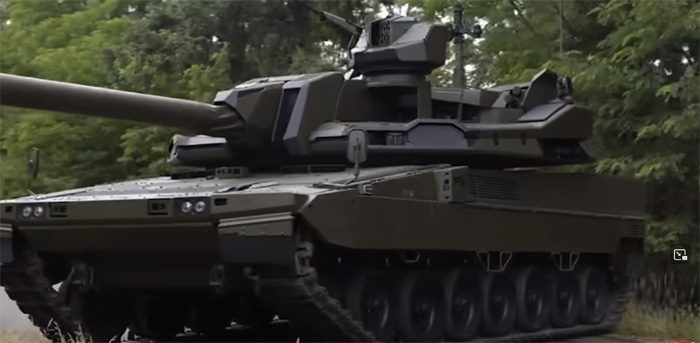
By December 2023 was unveiled at Cairo's Egypt Defense Exposition (EDEX) Nexter (French division of KNDS) showed its Enhanced Main Battle Tank (EMBT) with the whole Scorpion suite. The EMBT is a pure showcased, more serious this time, of Krauss-Maffei Wegmann and Nexter's combined components and features, with new features. The demonstrator indeed already rolled at Eurosatory in 2022 and a full year was needed, to flesh out more the initial "leoclerc" as it was dubbed in social medias. First driving tests were done and a press release with video appeared also attached. It features a 22-round 120 mm autoloader cannon, a revamped wheeled chassis plus 1,100 kW power pack, improved design, new digital architecture, and ARX 30 RWD on the roof with a 30 mm, plus the new active protection system (APS) and despite the autoloader, a fourth crew member dubbed the "deputy commander".
The hull and centra cmbat compartment also had been heavily reworked with then hull's bow and sides smoothed over, denying any contact surface for incoming projectiles. Thge turret is festered by optical sensors for detection and guidance with improved situational awareness for the driver, having multiple cameras. The turret is even flattier compared to the Leclerc's, but still presents many corners and edges due to the optics and sensors. The ARX 30 RWS and sensor turret makes the tank higher however, and is destrimental to reconnaissance and transport. At the exhibition it was presented next to the Leclerc. For now, the status of the current EMBT is unknown. It's likely to be a stepping stone on the path towards the final production EMBT of the MGCS program, if it ever succeed, but it's in frontal competition with Rheinmetall's Panther.
Leclerc XLR
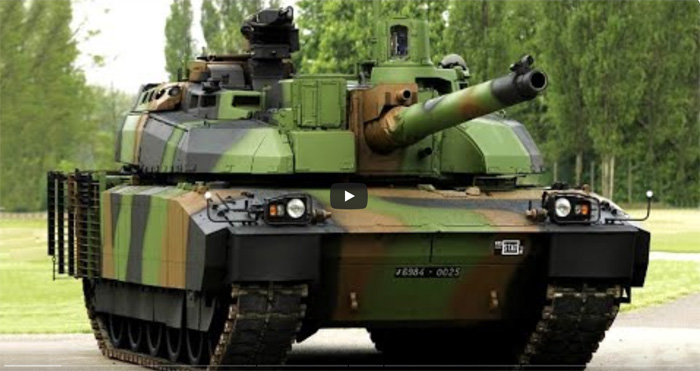
France did not rested idle by, and aside the massive Scorpion program being in final completion in budget and on schedule, Nexter revealed a major upgrade for the Leclerc MBT, aiming at ensuring a useful life extention up to beyond 2035 if needed. That 4rth-generation MBT is aiming at upgrading 200 Leclercs as announced in March 2015, with the first two prototypes for 2018 and remaining 198 to be upgraded over eight years from 2020 onwards under a €330 million contract. This is currently half the active Leclerc park. The other half is in depot. It should be noted that the UAE also operated 400 of them today and might be interested by the upgrade. On 1 January 2022, the Indian Army was rumored invited obver the 1,000 units replacement for its T-72 Ajeya fleet.
The Leclerc XLR (X for experimental, "L" for Leclerc, "R" for "Rénové") is part of the Scorpion program which emphasises battlefield awareness and inter-operation of many systems. It is developed and manufactured by Nexter, now since 2015 a division of KNDS. This intensive refit compriseds a new set of additional modular armour tailored for the latest threat, additional active protection systems, and a new turret-mounted RWD 7.62mm FN Herstal, rear wire cage armor against RPGs among others. The interior is completely refurbished as well with new displays and more ergonomic battle stations.
The electronic suite includes a networked architecture for better interfacing the Thales tactical radio system, NBC protection, night vision, and Atos SCORPION Information and Command System (SICS). The EW suite includes a counter-IED jammer, new interfaces and main system computers, software suite and master, new battle health monitoring system, better inertial navigation system/GPS nav fused into one. Display-wise, a lot was done for easier access to command, including vocal commands and information fusion to prioritize vital intel on both commander and gunner's displays. So far, the turret is still man-operated.
Design
As for now, the MGCS includes still an array of technologies that are far more ambitious than just an upgrade (Leopard 3 or 2A7+). According to the bi-national state research Institute of Saint-Louis (ISL) the new tank, which technical base is not yet fixed, would be able to deply unmanned ground vehicles and aerial ones. Its chassis would be able to be declined into a variey of vehicles, including an heavy IFV and a ARV (Recovery), CEV (engineering), AVLB (Bridgelayer). Ad to be able to deliver the range of options and capabilities of today's main battle tanks with however a far more advance integrated combat system, with emphasis on battlefield awareness and instant cloud-type collaborative approach of information sharing, coupled with the development of new tactics.MGCS expected specifications | |
| Dimensions | 2A7+, 10 meters overall, 3m high, 4m wide. |
| Weight battle ready | c70 tons |
| Crew | 4, 3 if autoloader (unlikely) |
| Propulsion | Likely MTU 2000hp diesel |
| Suspension | Active Hydropneumatic |
| Speed (road) | Beyond 70 kph governed |
| Range | c800 km |
| Armament | Rheinmetall 140 mm/60 |
| Total production | In Dev.2024, 3000+ expected EU market 2050 |
May 2024 Update: Leo 2 A-RC 3.0
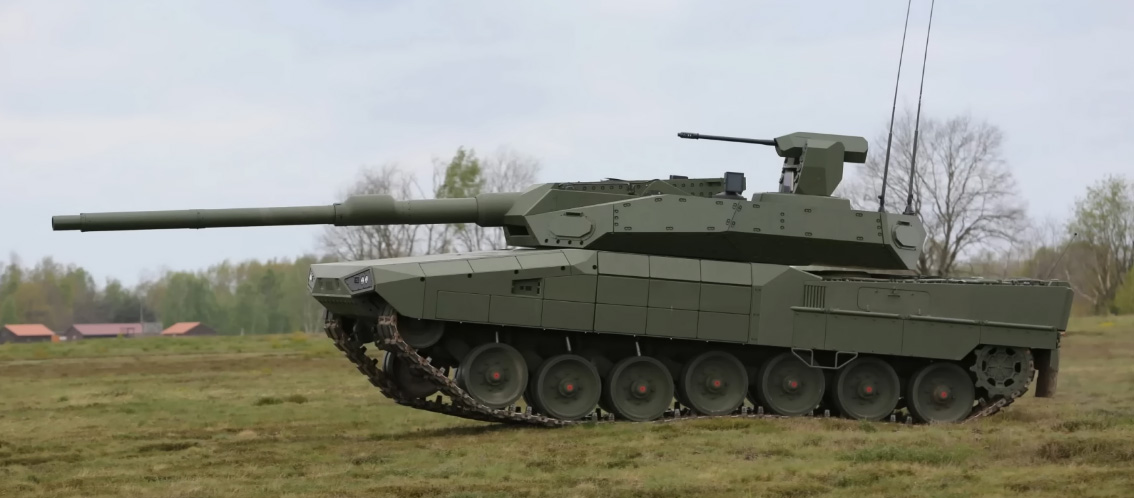
The novelty of Eurosatory 2024 is probably going to be the Leopard 2 "A-RC 3.0". This brand new KNDS model features a remote-controlled turret with modular automatic loading system. It is stated as having an open mount system enabling 120, 130 and even 140mm calibers to be mounts. Space is freed within the chassis for a fully enclosed crew compartment initially for a drive, commander and gunner since there is an autoloader above. The 2A7+ protection is complemented by a proven active protection system and for the first time, a drone-killer 30 mm remote weapon station. In addition there is a guided missile system. All it lacks is a smaller LMG. It is announced also as backwards compatible with the latest Leopard 2 variants for upgrades. A modular approach also aimed at export customers of the Leo 2A6. For the moment, the internal strife between Rheinmetall and KNDS about the MGCS is not fully solved; The new "Leopard 3" as it is calls by social medias is announced like an important step in the MGCS program still, but offers an upgrade for existing systems in the next years as well. Future will tell it this was a pure "concept tank" or a flavour of what is to come for the MGCS.
Sources/Links about the PzH 2000
The MGCS on armyrecognition.com, 2023The MGCS on defensenews.com
IAV 2024: German concept for MGCS doubles down on multi-platform solution
The MGCS split: Panther and EMBT
armyrecognition.com indian deal XLR
defence-blog.com XLR upgrade
The MGCS EMBT on esut.de/
The Leo 2A7 on armyrecognition.com
The MGCS 140 mm on id3486.securedata.net
The MGCS on defense-aerospace.com French-senate-report
The MGCS on en.wikipedia.org
Gallery
Illustrations

A hasty match, with Leo 2 chassis and standard Leclerc turret
The KNDS Eurosatory 2018 "leoclerc married the hull, engine and chassis of the Leopard 2A7 capable of carrying 68 tons, modified to to support the two-man autoloader-equipped Leclerc turret. It seems to have been merely a French initiative, while Nexter's Programmes dept. head Francois Groshany praised the combination of the "very high capability" Leopard 2 chassis with the light Leclerc turret as a chance to gain speed since the latter's turret is 6 tons lighter, enabling to traverse bridges ompassable by standard leopard 2A6/2A7. Since it was a "show tank" nothing is integrated and battle-ready. It is estimated that at least a year would be necessary to reach full integration. However so far this was not financed and no export customer was interested. It's more a "wink" showcasing KNDS capabilities.
Video: Presentation of the KNDS EMBT

Modern Tanks
Modern MBTs posters

Denel Bagder (2018)

Type 16 MCV (2016)

Gepard 1A2 last rounds 2011

SANDF

Russian AFVs

Main Battle Tanks

